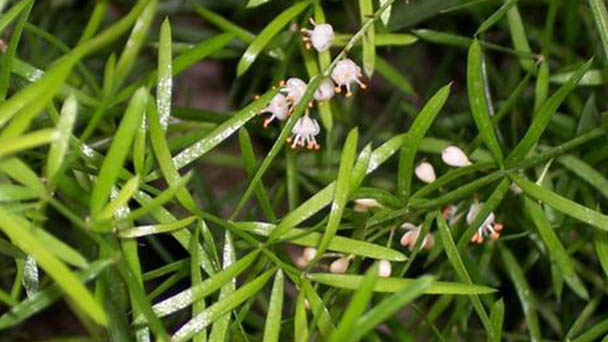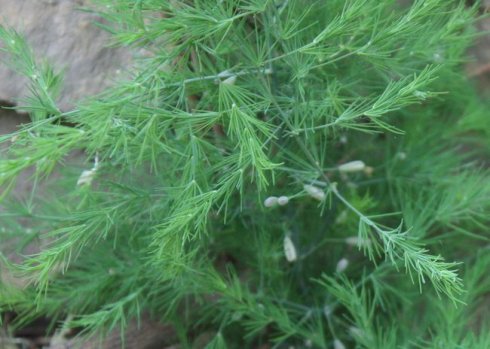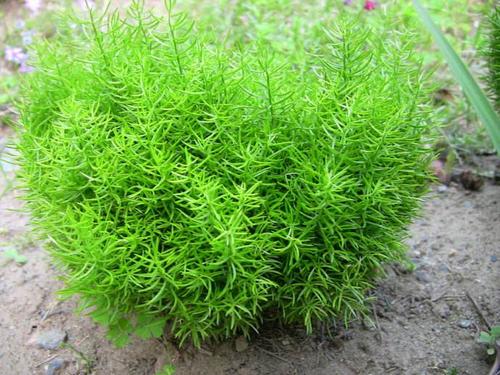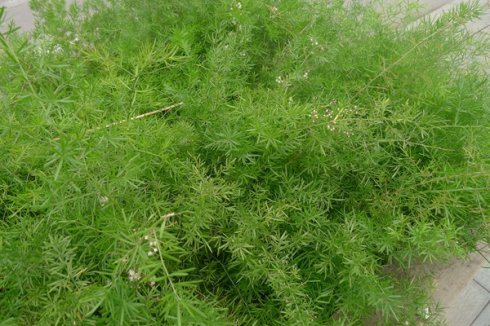Chinese asparagus profile
Written by Maggie
Jan 23 2021

Chinese asparagus, scientific name Asparagus cochinchinensis, has bright green leaflets in order to be born in scattered hanging stems. Chinese asparagus has both the beauty of asparagus, and elegant Chloropsis, very ornamental.
Chinese asparagus picture

Morphological characteristics of Chinese asparagus
Chinese asparagus (Asparagus cochinchinensis) is a perennial evergreen herb, a climbing plant. The root is spindle-shaped and expanded in the middle or near the end. The enlarged part is 3-5 cm long and 1-2 cm thick.Stems smooth, often curved or twisted, up to 1-2 m long, branches angulate or narrowly winged.
Leafy branches are usually in clusters of 3, flattened or slightly sharp triangulates due to midrib keel, slightly sickle-shaped, 0.5-8 cm long, ca. 1-2 mm wide; Scaly leaves on stems extend at base into stiff spines 2.5-3.5 mm long, with shorter or inconspicuous spines on branches.
Chinese asparagus (Asparagus cochinchinensis) flowers usually in 2 axillary, light green; Pedicels are 2 -- 6 mm long, joints usually midway, sometimes variate; Male flowers: perianth 2.5-3 mm long; Filaments are not adnate to perianth segments; Female flowers are similar in size to male flowers. Berries are 6-7 mm in diameter, red when ripe, with 1 seed.
Chinese asparagus with tuber roots, caespitose stems, sprawling and much branched, and hanging over the pelvic mouth. Leaf-shaped branches are linear, fascicled, very small, green. Racemes, florets pale red to white. Berries are globular and bright red. There are varieties of variegated and short asparagus.
The flowering period of Chinese asparagus (Asparagus cochinchinensis) is from May to June, and the fruiting period is from August to October.
Distribution area of Chinese Asparagus
Chinese Asparagus is distributed in the southern part of Hebei, Shanxi, Shaanxi, Gansu and other provinces to the eastern, central and southern parts of Southwest China. Chinese asparagus is also found in Korea, Japan, Laos, and Vietnam.
Chinese asparagus (Asparagus cochinchinensis) was born on slopes, along roads, under sparse forests, in valleys or on wasteland below 1750 meters above sea level.
Ecological habits of Chinese asparagus
Chinese asparagus (Asparagus cochinchinensis) likes warm, can not tolerate cold, and avoids high temperatures often distributed in the mountains below 1000 meters. Chinese asparagus is suitable for growth in regions with cool summer, warm winter and average annual temperature of 18-20 °C. Chinese asparagus likes shade, afraid of strong light, seedlings in strong light conditions.
Chinese asparagus (Asparagus cochinchinensis) has developed root tubers and the depth of human soil is up to 50 cm. It is suitable for growing in deep, loose, fertile, moist and well-drained sandy loam (black sand soil) or soil with rich humus.
The growing methods of Chinese asparagus
Water: Chinese asparagus likes wet, often need to spray water to the leaf in summer.
Fertilizer: Half a month application of light fertilizer 1 time, mainly phosphorus and potassium fertilizer.
Soil: Rich sandy loam, a mixture of leaf rot, crushed clay, and rotting horse dung.
Temperature: not cold, suitable for growth temperature 15-30℃. In winter, it is necessary to enter the room for Chinese asparagus overwintering, and the room temperature is above 5℃.
Light: Chinese asparagus is relatively resistant to shade, avoiding sun exposure. Store indoors in a dark place, not more than two weeks. Chinese asparagus can be placed in the sunny south window. Take Chinese asparagus out of the house and expose them to light for four hours a day.
Harvesting and processing
General planting needs 3 years to harvest chestnuts. In October to the second year in March before the germination, choose sunny days, first pull out the inserted rod, cut off the stems and vines of Chinese asparagus, and then dig up the soil around the root, carefully take out the root, shake to the soil, pick off the large work of medical, small root with root head left for seed. Remove root tubers of Chinese asparagus, cut off fibrous roots, remove silt with clean water, cook in boiling water pot for 10-15 minutes, remove peeling, peeling to use hands and knife at a time inside and outside two layers of the skin will be removed clean. Rinse the adhesive with clean water, and dry the surface slightly. Put Chinese asparagus in a sulfur tank (furnace) for 12 hours, so that its color is bright, and then take out the drying or drying. Best insolation night fumigation sulfonate, noon sun illumination is strong, bask in opportune time to cover with bamboo shade, prevent discoloration. The Chinese asparagus drying in the bamboo basket should be placed in a ventilated, cool and dry place.

The propagation mode of Chinese asparagus
Chinese asparagus can be propagated by sowing and division propagation.
Sowing propagation of Chinese asparagus
Germinate in about 1 month at 15℃ in spring and early summer. Sowing propagation of Chinese asparagus should be carried out when turning the pot. Because of the strong growth of the root system, it is necessary to change the pot every year. When changing the pot, part of the roots should be cut off and the large plant clusters should be planted in fractional clusters.
Division propagation pf Chinese asparagus
Cut out the Chinese asparagus, remove the soil, and cut off part of the root tuber, and divide the plant cluster into several clusters and Chinese asparagus. The seeding method is to pick seeds when the fruit is red in winter, and sow seeds in spring or early summer. The seedlings will emerge in about 30 days under the condition of 15℃. When the seedlings are 3-5 cm high, 3-5 plants will be planted in a cluster into a small pot. It is necessary to change the pot once a year, when the pot soil should be shallow, because the root system is strong. It is necessary to leave space along the mouth of the flowerpot, so as not to grow in the later stage. The vigorous root system of Chinese asparagus will top the pot soil to the surface of the pot, and there is no room for watering and fertilization.After turning over the basin, it should be placed in the half shade place. Fertilizer every 15-20 days. Early winter needs to move into the indoor maintenance, and control the moisture.
Disease control of Chinese asparagus
Starspider kills the leaves of Chinese asparagus. Prevention and control methods: (1) pay attention to the garden in winter, the dead leaves will be deep or burned; (2) Spray 0.2-0.3 Baume sulphur mixture or use 25% chloramine water agent 500-1000 times liquid spray, 1 times a week, 2-3 times in a row.
Aphids
Aphids will damage young vines and bud core of Chinese asparagus, making the whole vine atrophy. At the initial stage of aphid damage, it can be sprayed with 40% dimethoate 1000-1500 times diluent or meth aphids 1000-1500 times diluent. For Chinese asparagus with serious insect pests, all the vines can be cut off and applied fertilizer, and the new bud vine can be issued in about 20 days.
Root rot
The symptoms of chinese asparagus root rot are as follows: the root rot starts from the tail end of a root block and gradually progresses to the root head. Finally, the whole root block turns into a paste inside. After more than one month of onset, the whole root block turns into a black vacuole. This disease is more as a result of soil quality too moist or be bitten by underground insect pests, or soil fertilizer applied bump hurt be caused by. Prevention method: do a good job of drainage, in the diseased plant around some quicklime powder.
The function and purpose of Chinese asparagus
Decoration application
Chinese asparagus (Asparagus cochinchinensis) can be used as a small pot, and it is suitable for indoor ornamental pot, and it is also a good leaf arrangement for bouquet. Chinese asparagus is commonly used in a thousand barrel basin, placed on a few high frames, green leaves fine and soft hanging down like a waterfall, with a sense of movement.Can also be suspended to appreciate.
The international popular cultivation of Chinese asparagus, branches into upright shape, dense leaflet composition such as foxtail, beautiful. Potted Chinese asparagus is suitable for decorating family rooms or halls, and can also be cut stems and leaves as lining leaves for flower arrangement.
Medicinal value
The main treatment of Chinese asparagus (Asparagus cochinchinensis) is fever, cough, vomiting blood, lung impotence, lung carbuncle, sore throat, thirst, constipation, urination. Internal use: decoction, 2-4 yuan; Decorate cream or into pills, powder. Deficiency cold diarrhea and exogenous cold caused by cough should be avoided.
Chinese asparagus (Asparagus cochinchinensis) root tuber is a common Chinese medicine, which has the effect of moistening dryness, clearing fire and relieving cough.

Latest Updated
- Benefits of Bugleweed - 7 Science-backed Health Benefits
- Bugleweed Dangers & Side Effects - Is It Poisonous?
- How to Plant Evergreen Trees - What You Should Know
- When to Plant Evergreens - Grow Guide for Evergreen Trees
- 12 Wonderful Evergreen Shrubs for Your Garden
- 12 Popular Evergreen Plants with Pictures for Beginners
- When And How To Prune A Lilac Bush Like a Pro
- How to Grow & Care for Lilac Vine (Hardenbergia Violacea)
- Japanese Lilac Tree (Syringa Reticulata) Care & Propagation Guide
- Shumard Oak Pros and Cons - What to Know
Popular Articles
- Winter maintenance of Antirrhinum Majus
- How to Grow Terminalia Mantaly Tree
- How to Grow and Care for Crossostephium Chinense
- How to grow Antirrhinum Majus in spring
- Peristeria Elata (Dove Orchid) Profile: Info & Care Guide
- Underwatered Snake Plant (Sansevieria Trifasciata) - Signs And How To Fix
- How to Care for Brazilian Jasmine Plant (Mandevilla Sanderi)
- How to Grow & Care for Graptopetalum Purple Delight in Summer
- Rosa Chinensis (China Rose): Plant Growing & Care Tips
- How to Care for Baby Sun Rose (Aptenia Cordifolia)